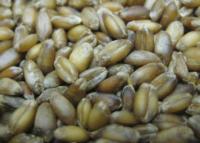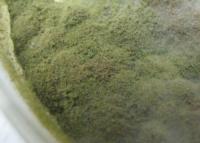Aflatoxins, which are potent toxins and carcinogens, are widely regulated by governments with the tolerances set very low in food. Aflatoxins are mainly produced by two closely related fungi, Aspergillus flavus and A. parasiticus, as they naturally grow in many crops, including corn, peanuts, and cottonseed. These aflatoxin-producing fungi also grow at low levels in pistachio nuts (Pistacia vera) in commercial orchards in California. However, the most common Aspergillus species found decaying pistachio nuts in California is A. niger, which does not produce aflatoxins and occurs substantially more frequently than the aflatoxin-producing fungi (Doster and Michailides, 1994b).
Naturally-occurring strains of A. flavus that are not able to produce aflatoxin (“atoxigenic” strains) have been used successfully to reduce aflatoxin contamination in cottonseed and peanuts. The atoxigenic A. flavus strain AF36 is currently being used in commercial cotton fields in Arizona, Texas, and southern California to substantially reduce the aflatoxin contamination of the cottonseed. Wheat carrying the atoxigenic A. flavus strain AF36 is applied in cotton fields to the surface of the soil only once each year in the late spring or early summer. After an irrigation, the wheat becomes rehydrated, allowing the AF36 fungus to grow and produce spores resulting in a predominance of the atoxigenic strain.

AF36 wheat seed before sporulation.
The atoxigenic
Aspergillus flavus strain AF36 (the same product that is widely used in Arizona cotton fields to substantially reduce aflatoxin contamination of cottonseed) was applied as a biocontrol agent in commercial pistachio orchards in California in 2008, 2009, and 2010. The AF36 strain was applied as a wheat-AF36 product (the same product and same application rate as used in commercial cotton fields) as a single annual application to the soil surface of the orchards in late June or early July. The level of the atoxigenic strain AF36 in the soil increased substantially in the treated orchards after applying the wheat-AF36 product. Prior to applying the AF36 product, only 2% of the
A. flavus isolates from the soil of these orchards belonged to the AF36 strain. But three months after the single application, 43% of the
A. flavus isolates in the soil belonged to the AF36 strain. After additional applications of the AF36 product were made in these orchards in 2009 and 2010, 92% of the isolates were AF36. This demonstrates that the application of the wheat-AF36 product was successful in substantially increasing the level of AF36 in the orchards.

AF36 wheat seed after 10 days at 30 degrees celsius.
Nonetheless, application of the wheat-AF36 product did not result in increased levels of kernel decay, and no cyclopiazonic acid was detected in nuts from treated orchards. Furthermore, nuts from the orchards treated with the AF36 product were less likely to be contaminated with aflatoxin than those from nearby untreated orchards in 2008, 2009, 2010 and 2011.



